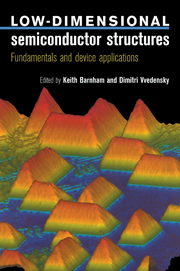Book contents
- Frontmatter
- Contents
- List of contributors
- Preface
- 1 Epitaxial Growth of Semiconductors
- 2 Electrons in Quantum Semiconductor Structures: An Introduction
- 3 Electrons in Quantum Semiconductors Structures: More Advanced Systems and Methods
- 4 Phonons in Low-dimensional Semiconductor Structures
- 5 Localization and Quantum Transport
- 6 Electronic States and Optical Properties of Quantum Wells
- 7 Non-Linear Optics in Low-dimensional Semiconductors
- 8 Semiconductor Lasers
- 9 Mesoscopic Devices
- 10 High-speed Heterostructure Devices
- Solutions to Selected Exercises
- Index
9 - Mesoscopic Devices
Published online by Cambridge University Press: 06 July 2010
- Frontmatter
- Contents
- List of contributors
- Preface
- 1 Epitaxial Growth of Semiconductors
- 2 Electrons in Quantum Semiconductor Structures: An Introduction
- 3 Electrons in Quantum Semiconductors Structures: More Advanced Systems and Methods
- 4 Phonons in Low-dimensional Semiconductor Structures
- 5 Localization and Quantum Transport
- 6 Electronic States and Optical Properties of Quantum Wells
- 7 Non-Linear Optics in Low-dimensional Semiconductors
- 8 Semiconductor Lasers
- 9 Mesoscopic Devices
- 10 High-speed Heterostructure Devices
- Solutions to Selected Exercises
- Index
Summary
Introduction
The semiconductor industry is a massive business and has a seemingly inexhaustible appetite for new devices, new materials and new applications. A single type of device can open up markets worth hundreds of millions of dollars if it can fill a suitable gap or demonstrate superior performance to those currently available. The rewards are even greater if the same device can then be integrated with many others. The high-electron mobility transistor, or HEMT (Chapter 10), is a good example of such a device. Conceived in the late seventies (Dingle et al., 1978), it was the focus of substantial research and development during the early 1980s (Mimura et al., 1980) and is now arguably the most important element in highspeed, low-noise communications systems such as those used in direct broadcast satellite television.
With such a powerful driving force it is not surprising that so much effort is devoted to researching new semiconductor device technologies. Low-dimensional systems have received particular attention during the last ten or fifteen years and as a result some elegant physics has emerged. It is therefore natural for physicists and engineers to explore ways in which the unique properties of low-dimensional structures might be exploited in devices of the future. Because these structures are usually in the size regime which lies somewhere between the microscopic world of atoms and the macroscopic world we live in, they are often lumped together under the single title of mesoscopic devices.
- Type
- Chapter
- Information
- Low-Dimensional Semiconductor StructuresFundamentals and Device Applications, pp. 296 - 347Publisher: Cambridge University PressPrint publication year: 2001



